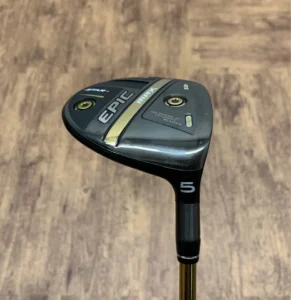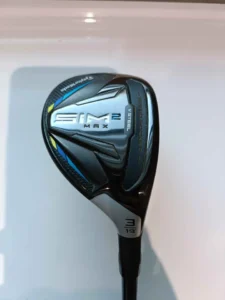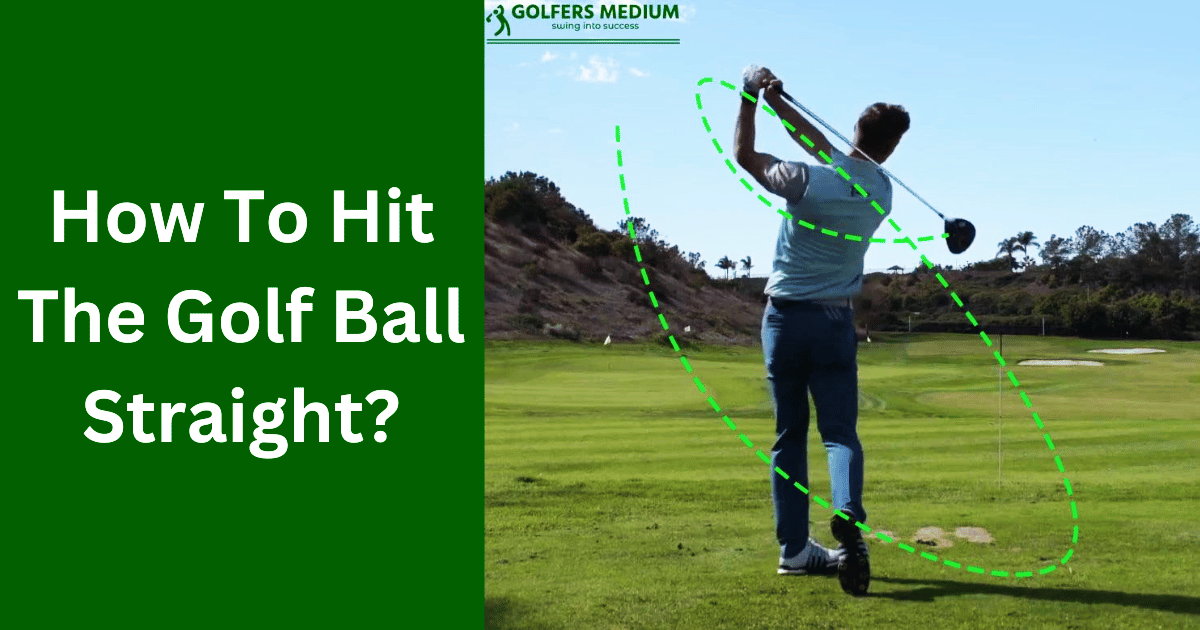If you are a beginner golfer then you should consider using a 3 hybrid instead of a 5 wood. A 3 hybrid is generally easier to hit and control than a 5 wood, making it a more suitable option for beginner golfers who are still developing their swing and building their confidence on the course. The deeper face and shorter length of a 3 hybrid also make it a more versatile club that can be used for a variety of shots, including approach shots, fairway shots, and even short par-3 holes.
What to expect after reading this article?
- A clear explanation of what a 5 wood and 3 hybrid are, including their design and purpose.
- A comparison of the key differences between the two clubs, such as their length, weight, loft, and face design.
- An assessment of the strengths and weaknesses of each club, including their suitability for different types of shots and golfing situations.
- Practical advice on when and how to use each club, including tips for maximizing performance and avoiding common mistakes.
- Recommendations for beginner, intermediate, and advanced golfers, based on their skill level and playing style.
Overall, we will try to provide you with clear, informative, and actionable information that will help you make informed decisions about which club you should use and how to use it effectively.
5 Wood vs 3 Hybrid – A Head-to-Head Comparison
Distance
A 5 wood typically has a longer shaft and a larger clubhead compared to a hybrid, allowing for more speed and longer distances on average. The loft on a 5 wood is typically lower (around 18-22°) which generates more roll and less lift, promoting distance over height.
Trajectory
Hybrids are designed to have a higher launch angle and more control over the ball’s flight. They usually have a more rounded clubface, a flatter lie angle, and a lower center of gravity, which promotes a higher ball flight with less spin. This makes them ideal for golfers who need to hit the ball over obstacles and land softly on the green. In comparison, a 5 wood will produce a lower, more boring trajectory, making it better suited for fairway shots or tee shots on par 3s.
Forgiveness
Forgiveness refers to a club’s ability to maintain a consistent ball flight even when struck off-center.
A 5 wood typically has a smaller clubhead and a more compact shape, making it less forgiving compared to a hybrid. Golfers using a 5 wood need to have a consistent swing to produce accurate shots, as off-center strikes will result in significant ball flight deviations.
On the other hand, a hybrid is designed with forgiveness in mind. It has a larger clubhead and a more rounded shape, which spreads out the weight of the club and helps to stabilize the clubhead at impact. This makes it easier for golfers to get the ball airborne and maintain accuracy even on off-center strikes.
Accuracy
5 wood has a longer shaft and a lower loft compared to a hybrid, which results in a straighter and longer shot but can also be less forgiving on off-center hits. A 3 hybrid has a shorter shaft and a higher loft, making it easier to get the ball up in the air and increasing accuracy on approach shots but sacrificing some distance.
Versatility
5 wood is a versatile club that can be used for a variety of shots, including tee shots, fairway shots, and even approach shots in some cases. A 3 hybrid, due to its higher loft, is best used for approach shots and shots out of bunkers or rough.
Shot-making
5 wood typically has a longer shaft and lower loft compared to a 3 hybrid, making it a more straightforward club that can result in straighter shots. However, the 5 wood may require a bit more skill to hit well, as it is less forgiving on off-center hits. A professional golfer who has good ball control and precision in their swing may prefer the 5 wood.
On the other hand, a 3 hybrid has a shorter shaft and higher loft, making it easier to get the ball up in the air and increasing accuracy on approach shots. This club is more forgiving on off-center hits, making it a good choice for professional golfers who may have a tendency to miss the center of the club face.
Why should anyone care about choosing the right club?
Choosing the right club is important because it directly affects the performance of your shots and overall game. Using the right club can help you hit more accurate and consistent shots, which can lead to better scores and a more enjoyable golfing experience. Additionally, using the wrong club can cause frustration, poor shots, and potentially lead to injury. It’s important to choose the right club for each shot to maximize your performance and minimize any difficulties.
Understanding 5 Woods

Design and specifications
- Length: 5 woods are typically 43-45 inches in length, making them longer than hybrids and most irons.
- Loft: The loft on a 5 wood can range from 15-18 degrees, which provides a higher trajectory and more distance compared to a fairway wood with a lower loft.
- Face Design: The face of a 5 wood is usually shallower than a hybrid, which allows the club to glide through the rough and rough conditions more easily. The face can also be more rounded or more pear-shaped, depending on the manufacturer.
- Weight: 5 woods can range from 190-220 grams, with lighter weight models allowing for more speed and distance, and heavier models providing more stability and control.
- Shaft Flex: 5 woods typically come in a variety of shaft flex options, from extra stiff to senior flex, to accommodate different swing speeds.
- Material: 5 woods can be made from a variety of materials, including steel, graphite, and composites, each with its own unique benefits and characteristics.
- Center of Gravity (CG) location: The CG location is an important design feature that affects the trajectory, distance, and forgiveness of the club. In general, a lower CG promotes a higher launch angle and more distance, while a higher CG promotes a lower trajectory and more control.
Advantages on the course
- Distance: With a loft ranging from 15-18 degrees, 5 woods can provide longer shots and more distance compared to lower-lofted fairway woods or irons.
- Versatility: With its longer length and higher loft, a 5 wood can be used for a variety of shots, including tee shots, fairway shots, and even approach shots, making it a versatile club for golfers.
- Control: The longer length of a 5 wood can provide more leverage and control on longer shots, allowing golfers to shape shots and hit precise targets.
- Forgiveness: Many modern 5 woods are designed with perimeter weighting and a low center of gravity, which can increase the club’s forgiveness on off-center hits.
- Rough and Rough Conditions: The shallower face design of a 5 wood can make it easier to play shots from the rough or tough conditions, compared to other clubs with a more vertical face.
Common misconceptions
- Only Professionals Use 5 Woods: While 5 woods are popular among professional golfers, they can be useful for golfers of all skill levels and handicaps.
- Only for Long Shots: While 5 woods are designed for longer shots, they can also be used for a variety of other shots, including tee shots, fairway shots, and even approach shots.
- Too Difficult to Hit: While 5 woods can take some time to get used to, they are not necessarily more difficult to hit than other clubs. With practice and proper technique, golfers can learn to hit 5 woods accurately and effectively.
- Have No Forgiveness: Many modern 5 woods are designed with perimeter weighting and a low center of gravity, which can increase the club’s forgiveness on off-center hits.
- Only for High Handicappers: 5 woods can be useful for golfers of all skill levels and handicaps, including low handicappers who are looking for versatility and control on longer shots.
Understanding 3 Hybrids

Design and Specifications
- Length: 3 hybrids are typically 39-41 inches in length, making them shorter than fairway woods but longer than most irons.
- Loft: The loft on a 3 hybrid can range from 19-24 degrees, which provides a higher trajectory and more distance compared to a short iron with a lower loft.
- Face Design: The face of a 3 hybrid is usually more vertical than a fairway wood, which provides a more piercing trajectory and more control on approach shots. The face can also be more rounded or more triangular, depending on the manufacturer.
- Weight: 3 hybrids can range from 160-190 grams, with lighter weight models allowing for more speed and distance, and heavier models providing more stability and control.
- Shaft Flex: 3 hybrids typically come in a variety of shaft flex options, from extra stiff to senior flex, to accommodate different swing speeds.
- Material: 3 hybrids can be made from a variety of materials, including steel, graphite, and composites, each with its own unique benefits and characteristics.
- Center of Gravity (CG) location: The CG location is an important design feature that affects the trajectory, distance, and forgiveness of the club. In general, a lower CG promotes a higher launch angle and more distance, while a higher CG promotes a lower trajectory and more control.
Advantages on the course
- Distance: With a loft ranging from 19-24 degrees, 3 hybrids can provide longer shots and more distance compared to lower-lofted short irons.
- Control: The shorter length and more vertical face design of a 3 hybrid can provide more control and accuracy on approach shots, allowing golfers to hit precise targets and shape shots.
- Forgiveness: Many modern 3 hybrids are designed with perimeter weighting and a low center of gravity, which can increase the club’s forgiveness on off-center hits.
- Rough and Tough Conditions: The more vertical face design of a 3 hybrid can make it easier to play shots from the rough or tough conditions, compared to short irons with a more horizontal face.
- Ease of Use: With its shorter length and higher loft, 3 hybrids can be easier to hit and use for golfers compared to longer fairway woods or lower-lofted irons.
Common Misconceptions
- Only High Handicappers Use 3 Hybrids: While 3 hybrids can be useful for golfers with high handicaps, they can also be useful for golfers of all skill levels and handicaps.
- Only for Approach Shots: While 3 hybrids are designed for approach shots, they can also be used for tee shots, fairway shots, and even longer approach shots, making them a versatile club for golfers.
- Too Difficult to Hit: While 3 hybrids can take some time to get used to, they are not necessarily more difficult to hit than other clubs. With practice and proper technique, golfers can learn to hit 3 hybrids accurately and effectively.
- Have No Distance: With a loft ranging from 19-24 degrees, 3 hybrids can provide longer shots and more distance compared to lower-lofted short irons.
- Only for Low Handicappers: 3 hybrids can be useful for golfers of all skill levels and handicaps, including high handicappers who are looking for control and ease of use on approach shots.
Choosing the Right Club for Your Game
Assessing your strengths and weaknesses
- Keep a record of your shots: Keep track of your shots, including the type of club used, distance, and accuracy. This information can help you identify patterns and tendencies in your game. If you want to learn more about the club selection for golf shots, click here.
- Evaluate your average distance: Take note of the average distance you hit with your current clubs, including your driver, fairway woods, and hybrids. This information can give you a baseline for what to expect from a 5 wood or a 3 hybrid.
- Assess your accuracy: Evaluate your accuracy by keeping track of your misses and the pattern of your misses. If you have a tendency to miss the center of the club face or struggle with getting the ball up in the air, a 3 hybrid may be a good option for you.
- Try out both clubs: Take some time to hit shots with both a 5 wood and a 3 hybrid and see how they perform for you. Pay attention to distance, accuracy, and the feel of each club.
- Seek professional advice: Consider getting a professional fitting to help determine which club would suit your game best. A professional fitter can analyze your swing and provide customized recommendations based on your specific strengths and weaknesses.
Evaluating the course conditions
- Tee Shots: If the course requires a long tee shot, a 5 wood may be the better choice as it typically has a longer shaft and can add some extra distance to your game.
- Fairway: If the fairways are tight or narrow, a 3 hybrid with its higher loft may be a better option as it can help get the ball up quickly and increase accuracy on approach shots.
- Rough: If the rough is deep and dense, a 3 hybrid with its higher loft may be the better option as it can help get the ball up and out of the rough more easily.
- Approach Shots: If the course has tight greens or bunkers, a 3 hybrid with its higher loft may be the better option as it can increase accuracy on approach shots.
- Wind conditions: If wind conditions are a factor, consider which club can help you maintain better control in the wind. A 5 wood with its lower loft may result in straighter shots, but a 3 hybrid with its higher loft can help reduce the effects of the wind on your shot.
- Personal comfort: Ultimately, choose the club that you feel most comfortable and confident with, regardless of the course conditions. Remember, golf is a game of confidence, so choose the club that makes you feel confident and ready to perform your best.
Factors to consider before making a decision
- Distance: Consider your average distance and the distance you want to achieve with each club.
- Accuracy: Evaluate your accuracy with your current clubs and consider how a 5 wood or a 3 hybrid may impact your accuracy.
- Course conditions: Consider the type of course you play, including the tee shots, fairways, rough, approach shots, and wind conditions.
- Budget: Keep in mind the cost of the club and whether it fits within your budget.
- Maintenance: Consider the maintenance required for each club, including regripping, cleaning, and any repairs needed.
Final thoughts on the 5 Wood vs 3 Hybrid debate
The debate over 5 woods vs 3 hybrids is one that has raged on for years, with golfers split between the two options. Both have their pros and cons, and ultimately, the best option for each golfer will depend on their individual playing style and preferences.
Frequently Asked Questions
Q1. What is the difference between a 5 wood and a 3 hybrid?
Ans: A 5 wood is a type of club used for longer shots on the fairway, typically with a lower loft angle than a 7 or 9 wood. A 3 hybrid, on the other hand, is designed for versatility and can be used for a variety of shots, including longer shots from the fairway, rough, or tee.
Q2. Which one is better for beginners?
Ans: For beginners, a 3 hybrid is often easier to hit and more versatile than a 5 wood, making it a better choice for those just starting out.
Q3. Is a 3 hybrid more forgiving than a 5 wood?
Ans: Yes, in general, hybrids are more forgiving than fairway woods due to their design and shape, which helps to reduce the impact of off-center hits.
Q4. Can a 5 wood be used off the tee?
Ans: Yes, a 5 wood can be used off the tee, although it is typically not the preferred club for tee shots due to its lower loft angle and longer shaft.
Q5. Is a 5 wood better for controlling the ball flight?
Ans: Both the 5 wood and 3 hybrid can be used to control the ball flight, but the 5 wood is typically preferred for players who want more control and the ability to shape their shots.
Q6. Which one has more distance?
Ans: The distance potential of a 5 wood and 3 hybrid can vary depending on the player’s swing and the club specifications, but in general, the 3 hybrid is designed for maximum distance.
Q7. What is the average loft for a 5 wood and 3 hybrid?
Ans: The average loft for a 5 wood is typically between 17-19 degrees, while the average loft for a 3 hybrid is usually between 19-21 degrees.
Q8. Can a 5 wood and 3 hybrid be used interchangeably?
Ans: No, the 5 wood and 3 hybrid have different design and loft angles, so they should not be used interchangeably. Players should choose the club that best suits their needs and playing style.
Helpful Related Articles
Also See
Hi! I am Hannah, a golf enthusiast, have been perfecting my swing for over a decade, making long putts a breeze. Aside from playing, I am a professional golf writer, I try capture the nuances of the game and inspire others to embrace their love for golf. Follow me on Twitter.




